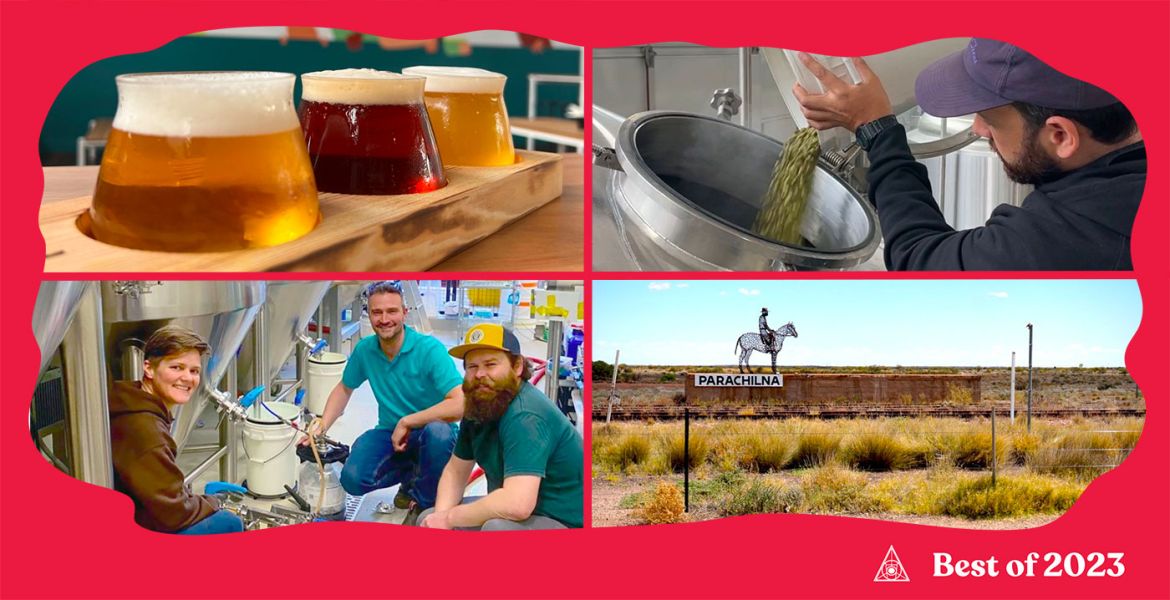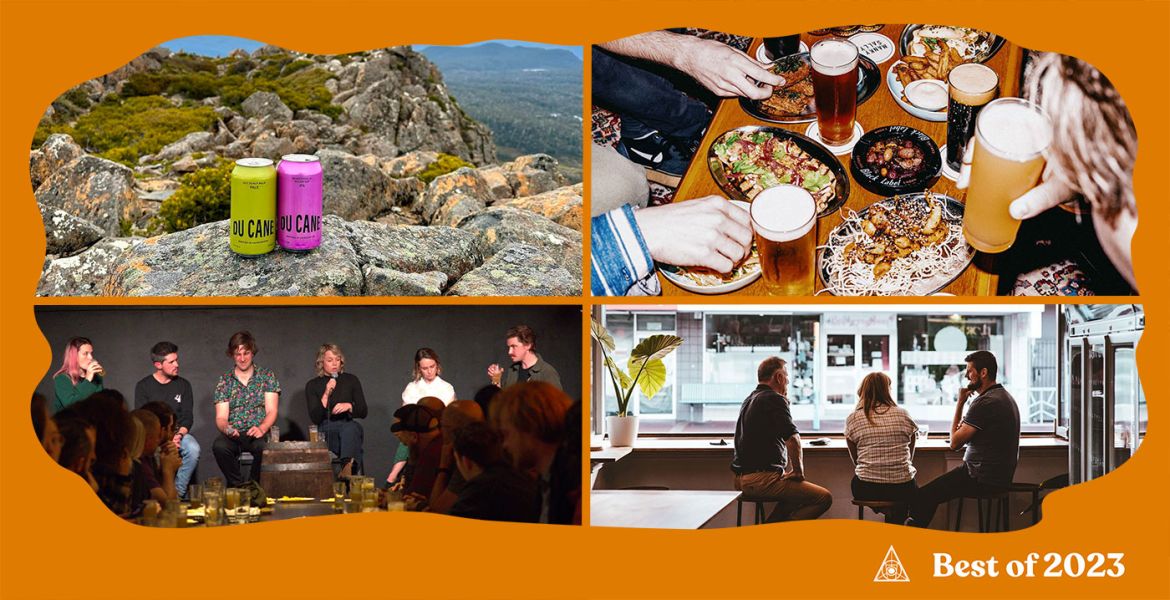So the end of the year is here and with it the final five beers in The Crafty Pint’s look back at 2010 through ten beers that combine quality with being representative of the current state of affairs in the Aussie craft beer scene and indicative of where it might be headed. As we stated in part one last week, this isn’t about merely picking our favourite ten, but trying to make sense of this exciting, fast-growing industry.
Holgate Beelzebub’s Jewels
It’s only a few hours now until the skies across Australia (except where there’s a total fire ban…) explode with fireworks, so why not go out with a bang? At the time of its release, this beer was the most expensive sold by an Aussie micro, clocking in at $50-plus for each of the 210 wax-sealed 750ml champagne bottles. The Beelzebub’s Jewels (or Devil’s Balls for short) had been through all manner of processes on its way to fruition – the base beer (Holgate’s Double Trouble Belgian Dubbel) was put into a barrel previously used for pinot noir into which were added extra fermentables, barrel hops and a champagne yeast to aid it on its journey to 12.5%. The result was a big, complex beer with all manner of sweet caramel and treacle flavours layered upon dried fruits and plenty of spiciness.

2011’s Beelzebub’s Jewels takes shape
Over 2010, we saw more breweries introducing these super-limited releases on top of their regular range and other seasonals: Lobethal’s fantastic Devil’s Choice, Nail’s Clout Stout (which topped the Jewels' price tag) and Hargreaves Hill’s velvety Phoenix Imperial Red to name but three. They’re never going to be beers that pay the brewers' bills or that win hordes of new converts to the craft beer cause but they’re a welcome addition to the scene as true special occasion beers that people will be popping at midnight tonight (New Year’s Eve) in place of champagne.
As for the Beelzebub’s Jewels, next year’s is already taking shape in barrels at the Woodend brewery, this time on a slightly larger scale and with a different recipe designed specially for the base beer. The plan is to make it an annual Easter Weekend release, cheeky chaps that they are.
Red Duck Loch Ness
Apologies in advance to the man himself, but whenever a new Red Duck beer appears on the horizon I can’t help but conjure images of brewer Scott Wilson-Browne as Dr Mephisto from South Park. While the cartoon mad scientist has a dubious obsession with genetically engineering animals with multiple buttocks, Scott instead focuses on creating weird and wonderful beers in his converted dairy in Victoria’s west. It’s debatable which was the most unusual of his 2010 releases, although it may come down to a toss up between the 14.3% Medieval braggot – a painstakingly contructed mix of mead and barrel-aged strong ale that was as much digestif as beer and is likely to come into its own further down the line – or the recent White Garden, a Berliner-Weisse / witbier hybrid with added rhubarb and raspberry.

In Crafty’s eyes, there was little doubt what was the best: the Loch Ness, a 6.7% Scotch Ale aged in whisky barrels. It was upon returning to it a few weeks after trying a pre-release bottle for listing on the site that it really worked its wonders: smooth, rich and creamy layers of warming chocolatey malts given a some zip and subtle smokiness by the aging process.
It also finds a place on the end of year list as a flagbearer for the breweries that might not have the same reach or commercial clout as some micros out there. Admittedly, it seems odd to write such a thing of what remains a tiny industry but there are definitely those that, by virtue of longevity, quality of their beers or greater shelf / tap space, are better known in the public sphere than others and have drinkers avidly awaiting their every release. For a change of scenery, it’s often worth digging a little deeper or picking up something you’ve not seen before. From True South’s New World Pilsner to Flying Horse’s Dirty Angel, Seven Sheds' Elephant Trunk or the award-winning Porter from the Hunter Brewing Company and many more besides, there’s plenty to be enjoyed off the beaten track.
Bottled Feral Hop Hog
It's no secret that this – a wonderfully full-flavoured yet clean, balanced marriage of malt and hops – is a fantastic beer and you could argue that it appears here a year late after losing the Champion Ale title to its little brother, Feral’s Runt APA, at this year’s Australian International Beer Awards. 2010 also saw the first release of a barrel-fermented version of the beer, with the time spent in new French oak added subtle nuances to an already excellent beer, so perhaps that should be here. What’s more, one could argue that if this list is to feature a Feral beer, why not the unusual yet delicious iWit 2.0 Imperial Witbier or the brewery’s funky sour beers, including an Australian first in the use of a beer fermented with wild Swan Valley yeasts? Well, Crafty would reply that 2011 is more likely to be the year of the sour as both Feral and Murray’s, in particular, ramp up their experimentation on that front – and it’s the qualification “Bottled” that is worth looking at.

This was the first year the Hop Hog appeared in packaged form, becoming only the second Feral beer to appear in 330ml bottles. The first was their Feral White and it's no great secret that the brewery had issues with the bottled version being made under contract for them; their concerns were such they worried that it was hurting their reputation outside WA where those who drank it on tap knew why it was also a serial award-winner. So, with the Hop Hog becoming their flagship beer among craft beer drinkers, there was no margin for error. Brewer Brendan Varis decided to handle the bottling in house and, unsurprisingly, no error was made. The beer lost little – if anything – in the transition from draught form to packaged, the result of great attention to detail, such as ensuring it travels to the East Coast in refrigerated transport rather than suffering on the journey across the Nullabor.
In achieving excellence with such a flagship beer, one that boasts so much hoppy goodness that it demands to be drunk as fresh as possible, it was a reminder of what can be done, as one factor that could undermine the spread of craft beer in Australia is quality control; who out there has never picked up a bottle of a microbrewed beer they love only to find it's oxidised, flat or merely stale?
While micros have plenty of battles to fight – making good beer, winning and retaining taps, shelf space and customers, fighting for a fairer tax regime – they need to keep the consumer happy too. That's why it's good to see so many brewers upgrading their bottling lines or starting to add batch numbers and best before dates to their beers. There are plenty of stages in a beer’s journey from brewery to drinker at which something can go awry: poor storage or transportation, dirty lines at pubs, bottleshop or bar owners aiming for a huge range without necessarily taking as much care over whether the beers are shifted promptly and so on. Therefore, ensuring the highest quality is maintained requires the buy in of everyone along the supply chain, because as the punter tastes more good beer and becomes more educated they'll know when something's amiss – and will head back into the comforting arms of something they can trust, such as the Hop Hog.
Bright Brewery Fainters 13 or Super Dubbel
OK. Time for the second curveball of the countdown. Like last week’s Black IPA from Temple, here is a beer that hasn’t been commercially available – and may never be – and has only been sampled by a few, yet is worthy of mention for what it says. The Fainters 13, or Super Dubbel, depending on who you speak to from the brewery, was the result of some experimentation by Bright owner Scott Brandon inspired by the high alcohol brews coming from crazy Scots BrewDog.

Taking the brewery’s Fainters Dubbel, an 8.5% Belgian beer, as the starting point and bringing an ice cream maker into the equation, he dabbled in a spot of freeze distilling – the process by which BrewDog were able to achieve their series of uber-strong beers: Tactical Nuclear Penguin, Sink The Bismarck and End of History. Scott didn’t push it as far as they did, instead knocking out a couple of tiny runs that came in at 13%. Of the result, Crafty said – among other things – that it “assaults the senses immediately with a hit of sweet malts, molasses and rich, dark fruit aromas” when tasted back in August and felt it boded well if Bright ever decided to take the trial further.
That the experiment worked is one thing, but the main reason the beer makes the list is that it happened at all. Anyone who’s been to Bright Brewery will know that it occupies an idyllic spot next to the Ovens River, surrounded by the Victorian Alps. With Bright being a popular spot for visitors all year round – and the brewery offering by far the best beer offering in town for locals – they’ve pretty much got a guaranteed clientele all year round and have no need to do anything wild to succeed. But they did. And it’s this spirit of adventure that makes the Aussie craft beer scene so bloody exciting.
Murray’s Punch & Judy
As one of the nation’s most adventurous breweries, Murray’s produce any number of beers over the course of a year that stand out from the crowd. What’s more the first time I ever tasted their Icon 2IPA, within months of arriving in Australia, remains the most “WTF!” Aussie beer moment I’ve experienced. This year’s Spartacus Imperial IPA was ridiculously drinkable for a 10%, 100IBU-plus beer while the Heart of Darkness was an almost undefinable mashup odyssey.

Yet it’s the Punch & Judy that may prove to have the greatest impact. Coming in at less than 4% ABV but without sacrificing flavour, it might help change perceptions Down Under of what lower alcohol beers can be. Plenty of the best British bitters have similar alcohol levels; in fact, this year’s Champion Beer of Britain is the truly delicious 3.8% Harvest Pale from Castle Rock – Crafty’s go-to beer before leaving the UK. Yet there seems to be a tendency in Australia to view anything under 4% as a midstrength or – horror! – a light beer, terms that bring hardened craft beer drinkers out in hives in the same way that suggesting they add a slice of lime to their beer might.
In creating the Punch & Judy, Shawn Sherlock and Ian Watson have taken those quaffable English beer garden ales and given them the Murray’s New Zealand hop twist to create a beautifully balanced, aromatic beer. It’s not the first Aussie beer to combine character with lower alcohol content but it’s possibly the best. Hopefully drinkers won’t shun it in the search for bigger, bolder beers and it will inspire other brewers to follow suit.
















